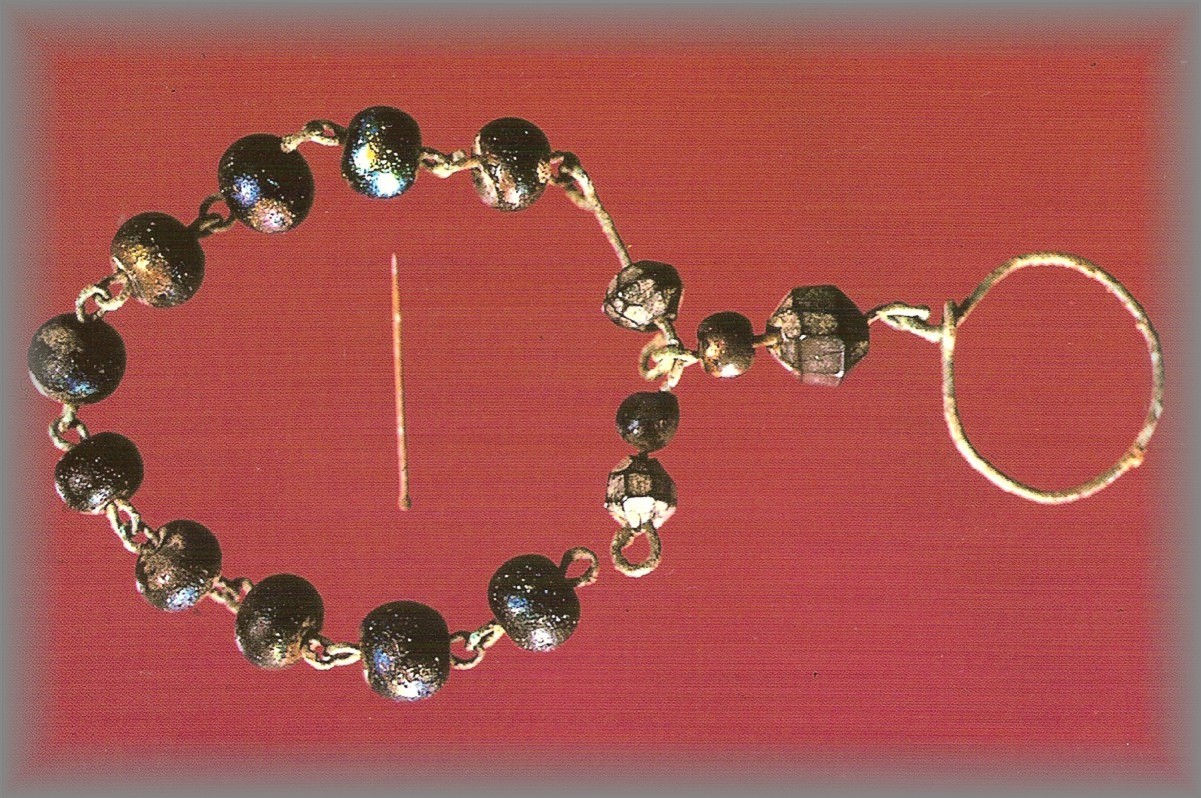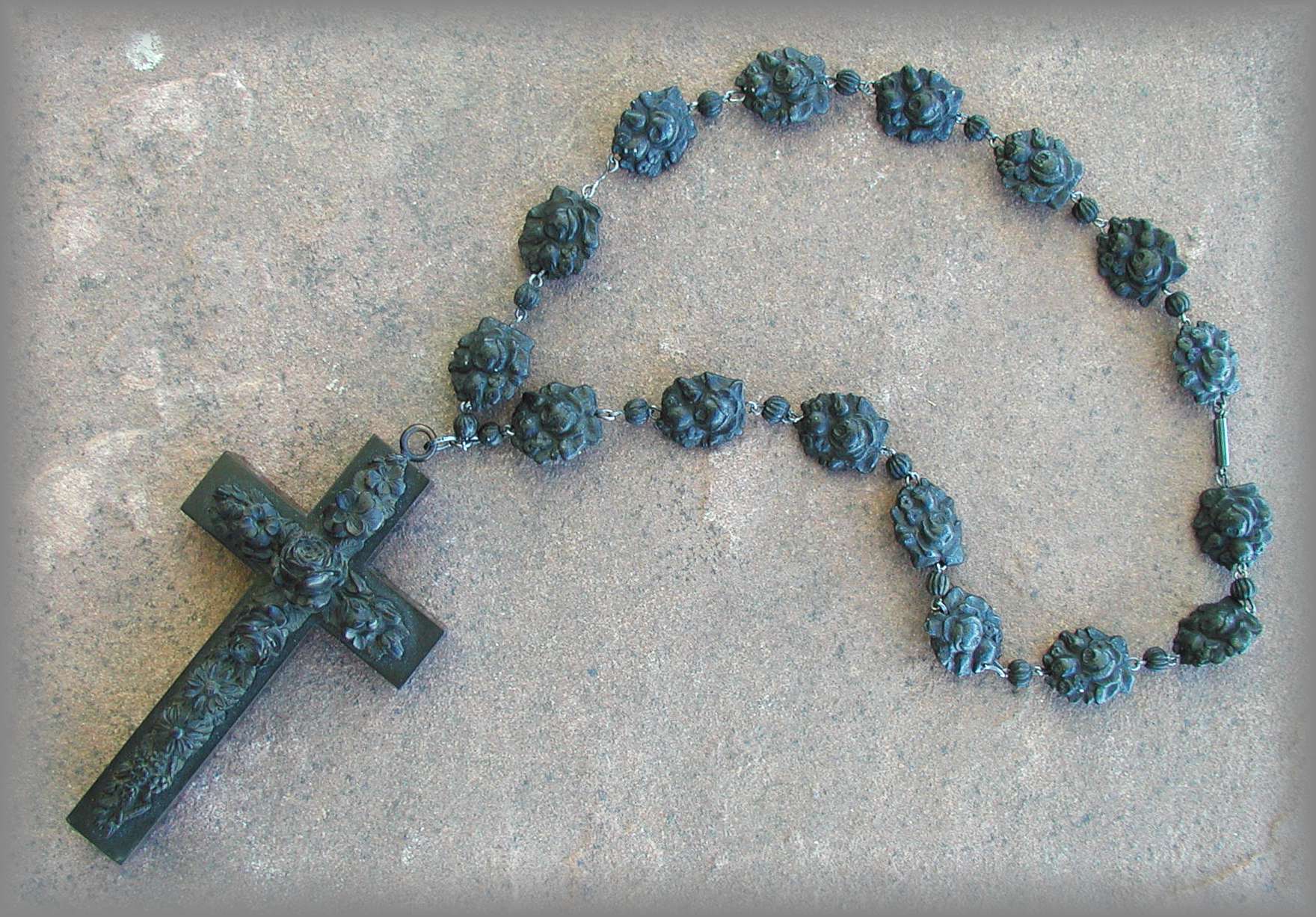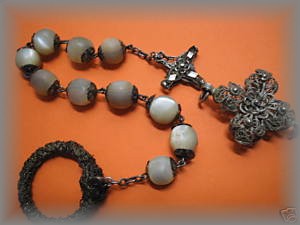| MUSEUM
Antique Rosaries |
HISTORY
of the Rosary |
for you index |
cord instructions |
LINKS |
EMAIL
US+
877 695 3561 |

St Marys City. Md - 1638 |

Irish Bog Rosary - 1760 |

|
|
+ MANY MYSTERIES In the world of rosaries and chaplets there are many mysteries! We thought it would be fun to ask you if you have any thoughts on the age, origin of some of these mysterious prayer beads. As this site grows, we hope you will come back and view how many of these treasures there are in the world. + Each helps to patch in a bit of history - what we know and don't know about rosaries and chaplets. And it helps us realize how many are unique because of not only confraternities but individual and personal prayer and available materials. These may have been identified but have you seen others that are similar ...? + ... Remembering that for many years confraternities and 3rd orders had special chaplets and rosaries with various bead configurations - long since lost in time - and that many broken rosaries were put back together by unknowing hands, we have a lot of curious prayer bead counters out there. With this in mind, we will collect and show you an adventurous few as they come in. for more information
see
|
|
*ST MARY'S CHAPLET* |
|
ALSO KNOWN AS A 'PALM ROSARY' The rosary was found in 1638 at the Saint John's site in Saint Mary's City [MD] in the foundation construction trench of the first major building. The rosary was most likely made in England and brought by the first Catholic settlers. The materials were made of glass beads and brass findings. the color beads originally black or blue. The beads have had a slight chemical reaction which took the outer layer of glass and made the beads irredesence. Mr. Henry Miller, Director of Research, Historic St. Mary's City told me the information concerning the rosary. The Jesuits were the religious order who built the church on the Saint Mary's City site. +
FIRST CATHOLIC SETTLEMENT I am an Elementary art teacher (Pre-K through 8) at Saint Michael's Catholic School in Ridge, Maryland. The school is located about five miles from Saint Mary's City, Maryland. Saint Mary's City, Maryland is considered the birthplace of religious freedom in the United States. This is the first Catholic settlement. http://www.stmaryscity.org/ + MY QUESTION IS How do you pray the rosary (pictured above) as the people did in the 1630's? What are the prayers, order of prayers and any information about these palm rosaries? + ROSARY WORKSHOP ANSWERED Rosary prayers as we know them now were pretty much in place by the 17c. The configuration
of beads may have been changed along the way. This often happens when links
come apart and someone unfamiliar with the sequence of prayer tries to
put it back together again. The 10 large beads would probably represent
the Aves of a single decade but the pray-er may have had other prayers
in mind, too. It could have used the extra 5 beads in a pendant form (standard),
which would take in the 2 Paters, Creed, Faith, Hope and Love
|
|
*CARVED BOGWOOD* IMAGES BY LINDA BULLOCK DESIGNS |
|
BOGWOODFROM IRELAND (The flowered cross - 3.75 in) + Hand carved bogwood beads from Ireland. A beautiful example of an old and very traditional Irish Rosary - very, very rare. The flowered cross (3.75 in) is beautifully hand carved to match the 16 beads. We do not know the prayer sequence for this chained rosary or if it is in its original configuration (13 inches from center back to tip of cross) + DETAIL OF BEADS
COMMENTS FROM THE OWNER The wood is very dark brown. The cross and the beads (16) are all carved with flowers from the same wood, which I have been told is Bogwood. It was believed to be carved at a convent in Ireland about 250 years ago. Dee Gleason + WHILE IN IRELAND When we were in Ireland last month I asked an antique dealer about old bogwood rosaries. She talked about the beauty of the hand carved bog rosaries (probably bog oak) and how hard they were to find - she mentioned that this was because they were usually buried with their owners. We are very grateful to Dee and her daughter who photographed this beautiful rosary for the museum . RW |
|
*CHAPLETS SEEN ON EBAY* |
|
These two chaplets are known by several names depending on their origin. Note both have 'thumb rings' (for passing chaplet from one finger to the other to complete the full rosary prayer. Also note the 'Credo Cruz (Credo Cross) to remind the pray-er tp asl for a deeper awareness of Faith, Hope and Love. + CREDO CRUZ & THUMB RING
(size unknown) + MOTHER OF PEARL AVE BEADS
(10.6 inches) + ABOVE Capped Mother of Pearl Aves with a filigree credocreuz and cross. Note finger ring is wrapped with a metallic gold passementerie cord. Dated by a German collector + These were seen on ebay (mvv4ever) and forwarded to us by 2 sources but no known information other than what we have added below. If you know anything about them, please let us know. |
|
*DECCA' ROSARY* |
|
This old one Decade [Decca] Chaplet has a Pater in the loop. the pendant begins with a Credo cross with a traditional crucifix hanging from it. Note the small metal element hanging from the botton of the hand cut crucifix. + CHAINED 'ZEHNER' ALSO KNOWN AS A 'DECCA'
ACTUAL AGE UNKNOWN Also see chaplet below along with others we have on site. +
+ COMMENTS FROM OWNER I think the time frame is much before the 19th - 20th century. One exactly like it was found on Sanibel Island by the archeology department of Florida State. It was of Spanish origin left there by the early Spanish explorers possibly around the 1600s or somewhat earlier. If you look into the early Spanish rosaries, you may find more about it. + If I can get it authenticated, I will place it in a museum - possibly one that you could recommend. I do not have a better picture of it, but may take it to a professional photographer, and see if I can get a good shot of it. Please keep in touch. With kind regards, Bill Scott |
|
*19c FILIGREE TENNER* |
|
SOLDERED TOGETHER A very interesting silver 'Tenner' made with filigree beads [two filigree caps soldered together]. Credo cross and traditional crucifix date this mid 19c Germany. Traditionally known as a 'Men's Zehner' or 'Tenner'. Includes the traditional Credo Cross. + TRADITIONAL BUDDING CRUCIFIX
COMMENTS FROM OWNER My cousin Linda Kolaszewski gave me your name. We found this chaplet in my mothers belongings. She doesn't remember anything about it. My brother and I don't remember ever seeing it before. Here it appears to be golden in color but it is actually silver in color. Can you give us any insight to this chaplet. Thank you. Joanne Kuhlmann, Canon City, Colorado + (Thanks, Joanne - Linda is our neighbor and a guild member) |
|
*SENDING YOUR IMAGES* |
|
Since this is an open museum for antique and vintage rosaries, we encourage you to send your images for consideration. Things we look for: CLEAR IMAGES (a must) - UNUSUAL CONFIGURATIONS AND MATERIALS USED + ANY INFORMATION YOU HAVE IS IMPORTANT If known, please include AGE - ORIGIN - SIZE If you don't know, possibly you have information on its owner, age or history. Please include anything you feel will identify your rosary or chaplet such as prayers, name of chaplets if known. Remember, the purpose of this site is for the student of the rosary - for those interested in the history of the rosary and how it has been used over the centuries. + WE MAY BE ABLE TO HELP So if you have no information, please do not let that stop you from sending it in. And if we cant help, we will ask for others to add their comments. + WELCOMING YOUR COMMENTS You may see rosaries and chaplets in our museum that you know something about, if so, please share - many have and it has become a wonderful resource for those who want to learn about the rosary and its history. + SEND ATTACHMENTS AND INFORMATION TO: Please identify your email ROSARY MUSEUM so it is not deleted by mistake. Mail information and images to: beadsong@hotmail.com |
|
1st CLASS
2nd CLASS
3rd CLASS
|
|
MISSION STATEMENT Our vision is to provide the finest handmade rosaries, chaplets and other fine religious art forms for personal worship we can make using the finest supplies available. The Guild believes the work of our hands should give visual Glory to God, therefore for us, the best for you is very, very important. +++
PMUSEUM
- HISTORY
- SHOPPING
for more informations
OFFICE
HOURS
|
|
secure-online - credit card -[or]- mail in - mo/personal check |